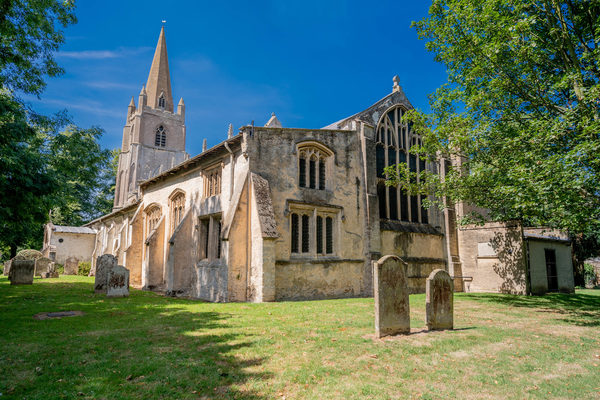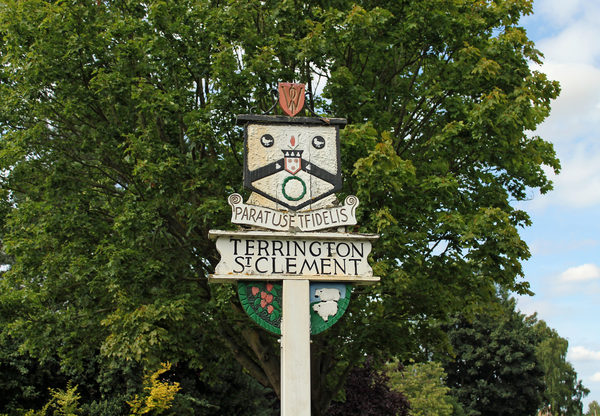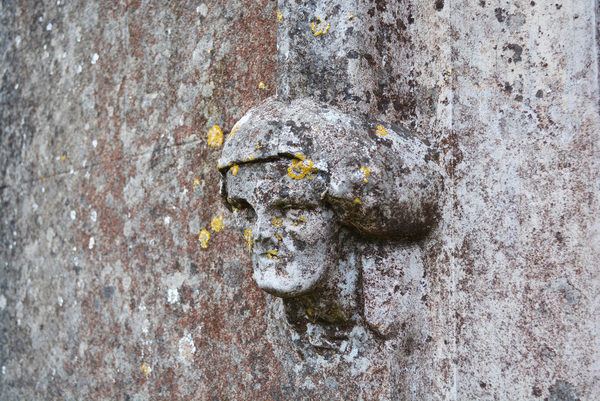Church of Saint Mary's dates from the 13th century built about 1240. It is unusual that the church's Bell tower is detached some 64 feet from the main building of the church. The tower is supported at its base by four open arches. At each corner stands a buttress which climb to the pinnacles with gabled niches in the first, second and third storey. The tower is topped with delicately carved parapet walls. The west doorway to the church is flanked on either side by massive buttresses, a result of remedial works carried out here after the foundations failed not long after the church was built. The south porch is arched with arcaded buttress on each side. The nave is arcaded with six bays on each side. The arches are supported on pillars which are encircled by detached shafts crowned with capitals of stone carved foliage. The hammer beamed roof dates from the 15th century and is supported by 24 carved angels holding shields.
The Western entrance of the church is dated from about 1240 with a central shaft or trumeau of Barnack stone, clustered Purbeck columns and stiff leaf carving retaining some traces of the original colouring. The elegant south porch is of similar date and features octagonal columns and dog-tooth ornaments.
The spacious six bay nave arcade is of outstanding design with its cylindrical columns and clustered marble shafts, all surmounted by deeply cut stiff leaf capitals. The clerestory and nave arcading are not aligned with each other, although are of similar date.
In the south aisle is an elaborate two-light Early English window with dog-tooth and rose designs carved in its capitals and mouldings, described by Pevsner as a perfect miracle of exquisite carving. This is almost certainly the only surviving original window in the church, the remainder having been altered in the 15th Century.
Wall paintings. The blind bays of the clerestory contain medieval wall paintings. The original ochre heraldic designs are contemporary with the construction of St Mary's. The spandrels between the arches of the nave arcade contain roundels emblematic of the tribes of Israel. These were painted over older geometrical roundels. Greater detail is given under nave wall paintings.
At the east end of the north aisle is an effigy of the founder in Purbeck marble, found in a fragmented state in 1847. It is closely paralleled by the monument of Bishop Kilkenny, d. 1257, in Ely Cathedral. Also in the north aisle is the tomb which commemorates the Repps family whose history can be traced back to the Eleventh Century. The Prior of Lewes leased the major part of the manor buildings to the family in 1533 and they were influential villagers from that date until 1650.
On the wall of the south aisle is a board erected by John Oxburch in 1677 recording three great floods which overflowed all Marshland in November 1613, March 1614 and September 1671. John Oxburch lies buried in the chancel.
The church contains a Churchwardens Chest made of elm coffin boards, and an 18th century iron carroon chest.
Other notable features in St Mary church are 15th century carved wooden benches in the Chancel, font, elevated on three octagonal steps, dating from about 1400.
The Hammer-beam nave roof is of 15th century origin with outstanding carving (there are suggestions it may have been adapted from another church). Each carved figure bears a shield carrying an emblem. These emblems relate to the Passion, with the exception of two that bear the arms of the Suffolk family of Jermyn.
The earliest evidence for an organ in St Mary's occurs in White's Gazetteer of Norfolk (1845) which states that an organ was presented to the church "a few years ago" by the Revd E E Blencowe, who was Rector from 1831 - 1869. The present instrument was installed by George Maydwell Holdich reputedly in 1893. It incorporates a six stop chorus of early 18th century origin, Holdich's contribution to the pipework being restricted to a pedal Bourdon, manual Gamba and extending the compass of the old stops beyond top. Holdich may have been rebuilding Blencowe's instrument (assuming it was second hand) or clearing existing stock prior to his imminent retirement. The organ was restored by Michael Latham of Northampton and re-opened in February 1996.
The decoration in the nave consists of three distinct schemes dating from the 13th, 17th and 18th centuries. The earliest work (c. 1240) is set on a background of lime wash on which red lines simulate masonry. The south clerestory panels contain painted imitation tapestries decorated with ornamental crosses, fleur-de-lys, rosettes, griffins, doves and fish. More careful examination of a simple geometrical pattern of yellow and red rectangles reveals rows of fish hanging to dry. Close inspection, during restoration work, showed that outlines of birds as well as grids for the tapestry and roundel designs were incised into the plaster, and imprints of compass points could be seen. Originally, the 13th century decoration continued into the spandrels of the nave arcade in a series of roundels. These have been overpainted in subsequent schemes, but half spandrels, whose design resembles a rose window, have survived at the east end of the nave.
The superimposed 17th and 18th century schemes depict ten of the tribes of Israel. Each roundel gives the tribe's name, has an appropriate emblem painted on a shield, and supplies a relevant biblical reference. In places elements of the 13th and 17th century decoration show through the subsequent reworking.








